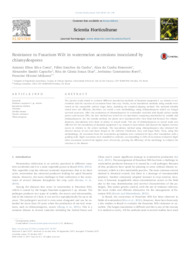Resistance to Fusarium Wilt in watermelon accessions inoculated by chlamydospores.
Resistance to Fusarium Wilt in watermelon accessions inoculated by chlamydospores.
Autoria: COSTA, A. E. S.; CUNHA, F. S. da; HONORATO, A. da C.; CAPUCHO, A. S.; DIAS, R. de C. S.; BOREL, J. C.; ISHIKAWA, F. H.
Resumo: The present study aimed to evaluate different inoculation methods of Fusarium oxysporum f. sp. niveum in watermelon and the reaction of accessions from this crop. Firstly, seven inoculation methods using conidia were tested on the susceptible cultivar Sugar Baby, including the standard dipping method. The methods initially tested were not efficient; therefore, we tested a new methodology using chlamydospores which are fungus survival structures. After the production of chlamydospores in vermiculite enriched with liquid culture media potato and sucrose (PS), the new method was tested on an experiment comparing inoculation by conidia and chlamydospores. For the conidia method, the plants were inoculated after their final leaf formed. For chlamydospores, inoculations were done in plants or sowed seeds. The use of chlamydospores in sowed seeds was effective for the inoculation of Fusarium oxysporum f. sp. niveum in watermelon and showed the highest severity scores in relation to the others methods. The inoculation method using chlamydospores also obtained the shortest means of root and shoot length in the cultivars Charleston Gray and Sugar Baby. Thus, using this methodology, 25 accessions from the watermelon germplasm were evaluated 21 days after inoculation with a grading scale. Eight accessions were classified as resistant, corresponding to 32% of accessions evaluated. Eight other accessions received the highest score of severity, proving the efficiency of the methology to evaluate the reaction to the disease.
Ano de publicação: 2018
Tipo de publicação: Artigo de periódico
Unidade: Embrapa Semiárido
Observações
1 - Por padrão são exibidas publicações dos últimos 20 anos. Para encontrar publicações mais antigas, configure o filtro ano de publicação, colocando o ano a partir do qual você deseja encontrar publicações. O filtro está na coluna da esquerda na busca acima.
2 - Para ler algumas publicações da Embrapa (apenas as que estão em formato ePub), é necessário ter, no celular ou computador, um desses softwares gratuitos. Sistemas Android: Google Play Livros; IOS: iBooks; Windows e Linux: software Calibre.
Acesse outras publicações
Acesse a Base de Dados da Pesquisa Agropecuária (BDPA) para consultar o acervo completo das bibliotecas da Embrapa.

